

Chuck Lickwar grew up near the Stanley company
where they made their hand planes. Chuck collects them, has almost every
version, and restores them for use, not for show.
With the correct and sharp plane Chucks says you can get a
smoothness better than 220 sandpaper.
|

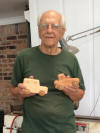
Lon Kelley played a video clip demonstrating how he
mass produced toy cars from planed and ripped two by fours.
So far Lon has produced 475 cars for the club’s Christmas toy
program. Click
video file to download a 5 1/2
minute 27MB file in MP4 format.
|

 
Getting ready for the craft show in November,
Norm Nichols created this plaque and plate.
The mule deer plaque is of red oak, stained with Golden Oak stain and
finished with polyurethane. The plate, a
Steve Good design, of mahogany is
stained with a clear stain, and also finished with polyurethane.
|
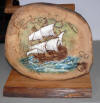
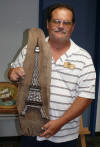 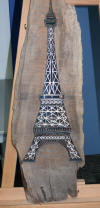
Using food coloring for stain Rick Spacek crafted
this ship out of spalted pecan from a pattern off the Internet.
Rick used a
Steve Good pattern for the Paris,
France, Eiffel Tower out of mesquite.
|
 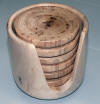


Using limbs from a pecan tree, ash and some mystery
wood, Larry Barron made these two bowls and a coaster set from
eucalyptus.
|
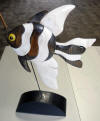

From a pattern on the Internet Ron Kirchoff
transformed a 2x6 pine into an intarsia fish.
He used different stains, some white wash and then finished in
lacquer.
|

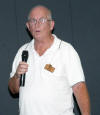
Cutting chunks from a four by four treated
fence post, Larry Wenner’s cut offs revealed very interesting patterns.
|

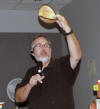

Dean Grimes showed some lathe turned bowls
of mimosa and sweet gum. |
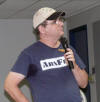
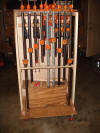 In Mark Bolinger’s never ending quest for
organization, and claiming that he doesn’t need any more clamps (we’ll
see), Mark built a clamp rack to fit in a particular spot in the shop.
His clamps are now closer to his work bench – a big improvement.
See more photos of Mark's
clamp rack.
|

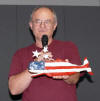  Chuck Meeder found a couple of patterns in
Woodcarving Illustrated which he
couldn’t resist. Scroll sawed from
basswood, Chuck crafted a whale and pastry wheel.
For the wheel Chuck used spray acrylic to seal the wood and then
used coloring from a water soluble acrylic paint.
To create the antique look on the whale Chuck sanded with 220
grit sandpaper, some dark get stain left on as long as he could then
some spray acrylic on top of that.
The angel is of basswood and the wheel is of cherry then finished
with mineral oil.
Chuck Meeder found a couple of patterns in
Woodcarving Illustrated which he
couldn’t resist. Scroll sawed from
basswood, Chuck crafted a whale and pastry wheel.
For the wheel Chuck used spray acrylic to seal the wood and then
used coloring from a water soluble acrylic paint.
To create the antique look on the whale Chuck sanded with 220
grit sandpaper, some dark get stain left on as long as he could then
some spray acrylic on top of that.
The angel is of basswood and the wheel is of cherry then finished
with mineral oil.
|

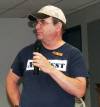
Mark Bolinger showed club members slides of his progress with his
dust collector. Why so much
work involved? Knick-knacks on the mantle do the same thing.
|
 
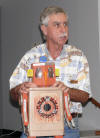
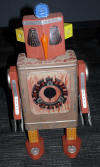
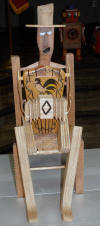
Bob Wink admits to using some wood with his robot
and appreciated his chair being “compared” to a Sam Maloof project.
Growing up in Cajun country Bob crafted a Cajun musician plalying
his
squeeze box.
The gas tank pulls a trailer with a fishing boat.
More great whimsical folk art!
|
 
  
Specializing in period furniture Jack Hutchison
showed club members his 18th century spice box made of
walnut, a gift for his wife.
Jack explained the many features of his craftsmanship.
|
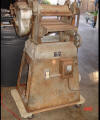
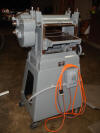
Mark's planer before and after.
This is Mark's carriage for
moving heaving equipment around the shop:

Download his video in MP4 format showing how Mark's
carriage works. |
WWCH’s own Mark Bolinger,
lead of the Hand Tool Splinter Group, spoke to club members about
restoring Old Wood Working Machines (OWWM).
What is OWWM?
Basically it refers to woodworking machinery that was manufactured in
American or Europe typically at least 25 years ago. OWWM also covers
just about any old machine.
There is a lot of information on the Internet and there is an annual
ArnFest held in
Union, Illinois, where folks interested in old machinery gather.
Mark spoke about sources such as Craig’s List,
classified ads and ebay. Of
interest is a process called “Ruckering”
where people form a network, sort of like a human “chain” to arrange
delivery of a piece of equipment.
Imagine shipping charges for a 600 pound bulky machine and you'll
see why Ruckering is advantageous.
Mark provided numerous tips and advice on what
to look for when acquiring an old tool.
For broken parts, reject if too severe.
Examine gears for wear, the condition of table surfaces, bearings
and motors. Tables can be
cleaned of rust, minor pitting ground out but severe pitting would
require a professional machine shop to flatten.
Bearings are usually not an issue, they can be replaced – look
for seized bearings – more trouble. Motors can usually be restored or
replaced.
Nowadays you can purchase 1-phase to 3-phase
converters at reasonable prices so 3-phase motors should not be an issue
unless it runs on 440 or requires high amperage.
Restoration is part of the fun for Mark, not
just having a tool in the end. Machine restoration is not a one-weekend
project so take your time.
Old woodworking machines are typically heavy so
Mark devised a simple carriage to move a machine around the shop.
Download this one-minute
video that demonstrates his
carriage.
Mark provided some examples of his restoration
work as you can see in these photos to the left and right.
|


Mark's jointer before and after. |
|
************************************************************************************************************
|
|
Photos and commentary: Gary Rowen
|
|
|
|
|
|





